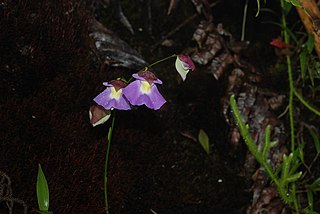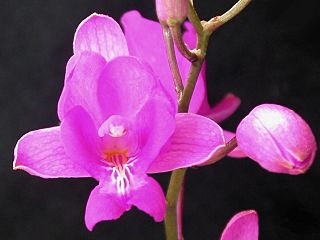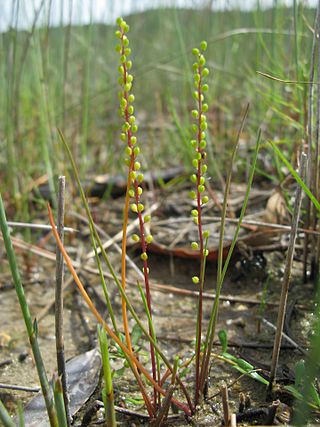Huertea is a genus of plant in family Tapisciaceae. It is native to central and south America. Species include:

Utricularia unifolia is a species of perennial, medium-sized carnivorous plant that belongs to the family Lentibulariaceae. U. unifolia is native to Central America and western South America. It was originally published and described by Hipólito Ruiz López and José Antonio Pavón Jiménez in 1797 and later considered a synonym of Utricularia alpina until Peter Taylor's 1989 monograph on the genus where he restored the species as distinct from U. alpina. It grows as a terrestrial or epiphytic plant on moss-covered trees, rocks, or banks in cloud forests at altitudes between 2,000 m (6,562 ft) and 3,000 m (9,843 ft). U. unifolia usually produces only one leaf, which is where the species epithet "unifolia" is derived from.

Bowlesia incana is a species of flowering plant, known by the common name hoary bowlesia, in thefamily Apiaceae. It is native to South America and the southeastern and southwestern United States as far north as Washington. It can also be found in Pakistan and New Zealand as an introduced species. It grows in many types of habitat. This is a small annual herb growing thin, spreading stems less than 60 centimeters long. The leaves are borne on long petioles and have multilobed rounded or kidney-shaped blades less than 3 centimeters wide. The green herbage of the plant is coated in fine white hairs. The inflorescences of yellow-green flowers appear in the leaf axils. The tiny inflated fruit is only 2 millimeters wide.

Salvia oppositiflora is a species of perennial flowering plant in the famiily Lamiaceae. It is native to Peru, growing at high elevations—7,000 to 12,000 feet. It was collected in 1798 by Hipólito Ruiz López and José Antonio Pavón Jiménez and later described in Flora of Peru.

Salvia sagittata is a species of herbaceous perennial plant in the family Lamiaceae. It is native to the Andes Mountains, growing at elevations from 9,500 to 10,500 ft. The specific epithet refers to the arrow-shaped leaves. The plant was collected and named in 1798 by Hipólito Ruiz López and José Antonio Pavón Jiménez, two Spanish botanists who spent ten years in Peru and Chile on a commission by the government of Spain to go to the New World in search of new medicinal and agricultural plants.

Anguloa uniflora, commonly known as the swaddled babies orchid, is a species of orchid in the family Orchidaceae. It is the type species of its genus.

Bletia catenulata is a species of orchid in the family Orchidaceae. It is native to Ecuador, Peru, Brazil, Colombia, Bolivia and Paraguay.

Triglochin striata is a species of flowering plant in the family Juncaginaceae. It is native to New Zealand, South America, America, Africa, Australia and Southern Portugal.

Pitcairnia paniculata is a species of flowering plant in the family Bromeliaceae. This species is native to Bolivia.

Tillandsia biflora is a species of flowering plant in the family Bromeliaceae. It is native to Panama, Nicaragua, Colombia, Peru, Bolivia, Costa Rica, Venezuela and Ecuador.

Tillandsia capillaris is a species of flowering plant in the family Bromeliaceae. This species is native to southern and western South America.

Tillandsia purpurea is a species of flowering plant in the family Bromeliaceae. It is endemic to Peru, first described by Ruiz and Pavón in 1802.

Carludovica palmata is a species of flowering plant in the family Cyclanthaceae. It is not a true palm, but its leaves are very similar compared to the leaves of some true palms, for example, to Chelyocarpus ulei. Unlike several true palms, C. palmata does not develop a woody trunk. Its female flowers have large stigmas, and its male flowers have a lot of pollen.

Gaiadendron is a genus of parasitic shrubs or trees in the family Loranthaceae. It solely comprises the species Gaiadendron punctatum, which is found in North and South America.

Cavanillesia umbellata is a species of trees in the family Malvaceae. It is native to South America.

Persea caerulea is a species of evergreen tree in the laurel family, Lauraceae. It is native to North and South America.
Godoya obovata is a species of tree in the family Ochnaceae. It is native to South America.

Fuchsia apetala is a species of small shrub or vine in the family Onagraceae. It is native to Bolivia and Peru.

Campomanesia lineatifolia is a species of plant in the family Myrtaceae. Common names include guabiraba and perfume guava.

Tristerix verticillatus is a species of flowering plant in the family Loranthaceae. It is found in Argentina, Bolivia, and Chile.

















